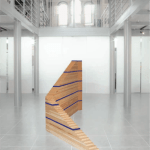Mehdi Moutashar French-Iraqi, b. 1943
Alif, 2004
Wood, acrylic paint
114 x 342 x 110 cm
44 7/8 x 134 5/8 x 43 1/4 in
44 7/8 x 134 5/8 x 43 1/4 in
The general outline of the artwork refers to the line drawn by a calligrapher with a qalam (reed pen). It starts at the top, when the qalam is fully charged...
The general outline of the artwork refers to the line drawn by a calligrapher with a qalam (reed pen). It starts at the top, when the qalam is fully charged with ink, and the line thins out as it descends towards the end of the letter. In the history of calligraphy, the design of the letter Alif is made up of a succession of seven diamond-squares, and corresponds to the diameter of a circle.
Initially, with this work, the upper square-diamond was drawn offset from the other six. Gradually, this first diamond-square transformed, widening to highlight the upper limit of the letter. It is to this particularity that the work pays homage, by adding a rectangular shape in relief made up of two diamond-squares - a device which also made it possible to give better stability to the upper part of the construction. The work consists of 60 wood pieces, staged in five sections, each underlined by a layer painted in ultramarine blue. The design echos Mesopotamian architecture, which would later influence Muslim architecture in its use of color.
Initially, with this work, the upper square-diamond was drawn offset from the other six. Gradually, this first diamond-square transformed, widening to highlight the upper limit of the letter. It is to this particularity that the work pays homage, by adding a rectangular shape in relief made up of two diamond-squares - a device which also made it possible to give better stability to the upper part of the construction. The work consists of 60 wood pieces, staged in five sections, each underlined by a layer painted in ultramarine blue. The design echos Mesopotamian architecture, which would later influence Muslim architecture in its use of color.



